Table of Contents
- Introduction
- Editor’s Choice
- Digital Content Creation Market Overview
- Different Types of Digital Content Creation
- Number of Digital Content Creators Worldwide – By Country
- Time Spent Creating Digital Content by Social Media Creation Worldwide Statistics
- Earnings of Digital Content Creation Statistics
- Digital Content Creation and Management Technology Statistics
- Challenges in Digital Content Creation Statistics
- Recent Developments
- Conclusion
- FAQs
Introduction
Digital Content Creation Statistics: Digital content creation encompasses the production of diverse media content for online consumption, spanning written articles, videos, podcasts, graphics, and interactive experiences.
With the proliferation of digital platforms and increased internet penetration, demand for engaging content is surging.
Video content remains dominant, with platforms like YouTube and TikTok driving engagement. While emerging formats like live streams and AR offer new engagement opportunities.
Content creators, platforms, agencies, and technology providers constitute the market landscape. Navigating challenges such as content saturation and algorithmic changes while capitalizing on opportunities in monetization models and emerging technologies like Generative AI and VR.
Understanding these dynamics is crucial for businesses and creators aiming to thrive in the competitive digital content space.
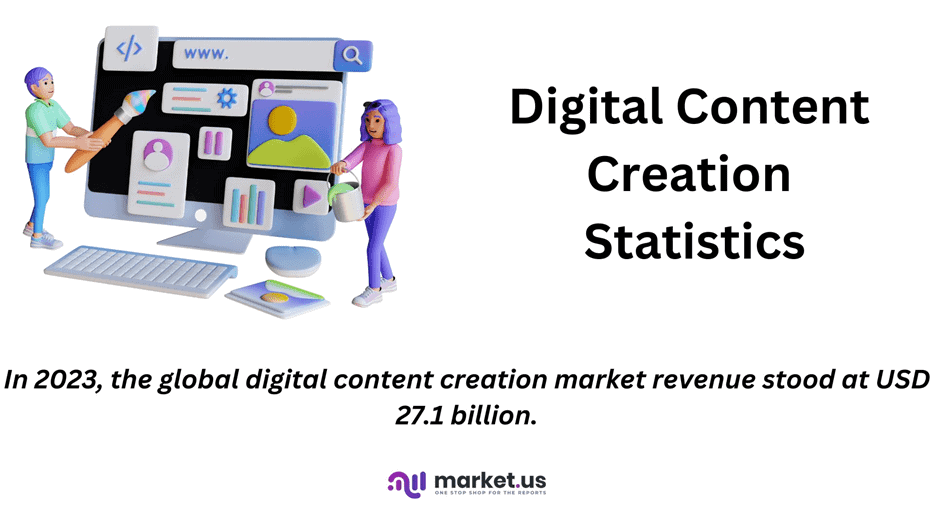
Editor’s Choice
- In 2023, the global digital content creation market revenue stood at USD 27.1 billion.
- By the end of 2033, the total market is projected to climb to USD 90.4 billion, with tools generating USD 67.62 billion and services reaching USD 22.78 billion. Indicating a robust expansion and sustained demand across both segments.
- Various types of content categorize the market, each holding a significant share. Video content dominates the market with a 40% share, reflecting its widespread use and high consumer engagement.
- In the 2022 HubSpot State of Content Marketing Report, it was found that 56% of marketers believe blogs are the most effective type of content.
- A recent HubSpot survey revealed that a significant 82% of content creators and marketers repurpose their content for social media platforms.
- Brazil leads in the distribution of digital content creators with a substantial number. Hosting approximately 106 million digital content creators, the highest among surveyed nations.
- In 2017, the earnings of U.S. creators on leading platforms exhibited varied growth and decline relative to the previous year. YouTube led with significant earnings of approximately $4,004 million, marking a 21.10% increase from 2016.
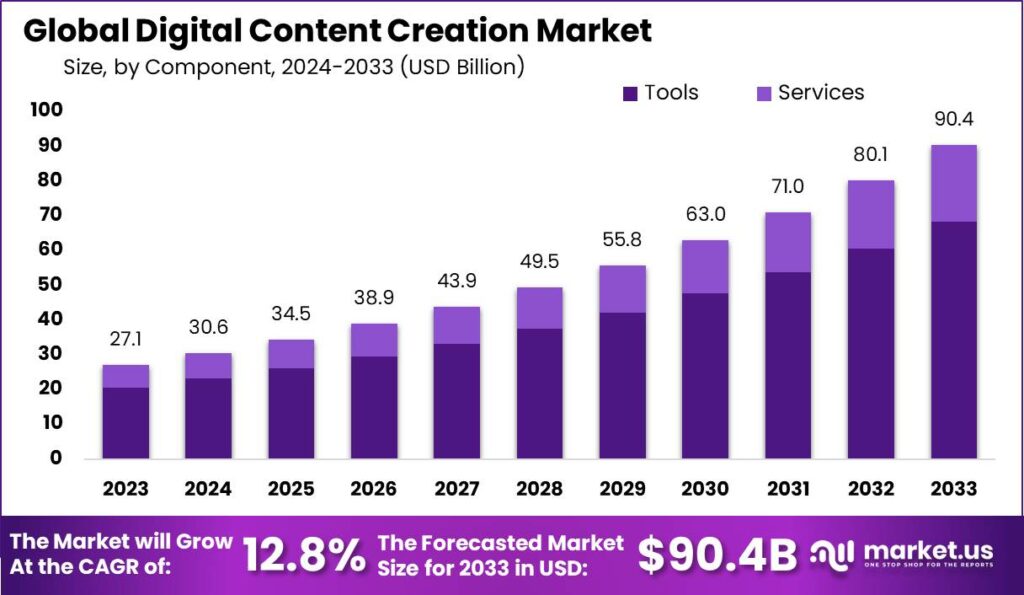
Digital Content Creation Market Overview
Global Digital Content Creation Market Size
- The global digital content creation market is projected to exhibit significant growth over the next decade at a CAGR of 12.8%.
- In 2023, the market revenue stood at USD 27.1 billion. It is forecasted to rise to USD 30.6 billion in 2024 and continue its upward trajectory to reach USD 34.5 billion by 2025.
- By 2026, the revenue is expected to increase further to USD 38.9 billion, followed by USD 43.9 billion in 2027.
- The momentum is anticipated to carry forward, with the market reaching USD 49.5 billion in 2028, USD 55.8 billion in 2029, and crossing the USD 60 billion mark to USD 63.0 billion in 2030.
- The growth trend is set to persist, with market revenues projected at USD 71.0 billion in 2031 and reaching USD 80.1 billion by 2032.
- By the end of 2033, the market is expected to surge to approximately USD 90.4 billion. Illustrating a robust expansion over the ten years.
(Source: market.us)
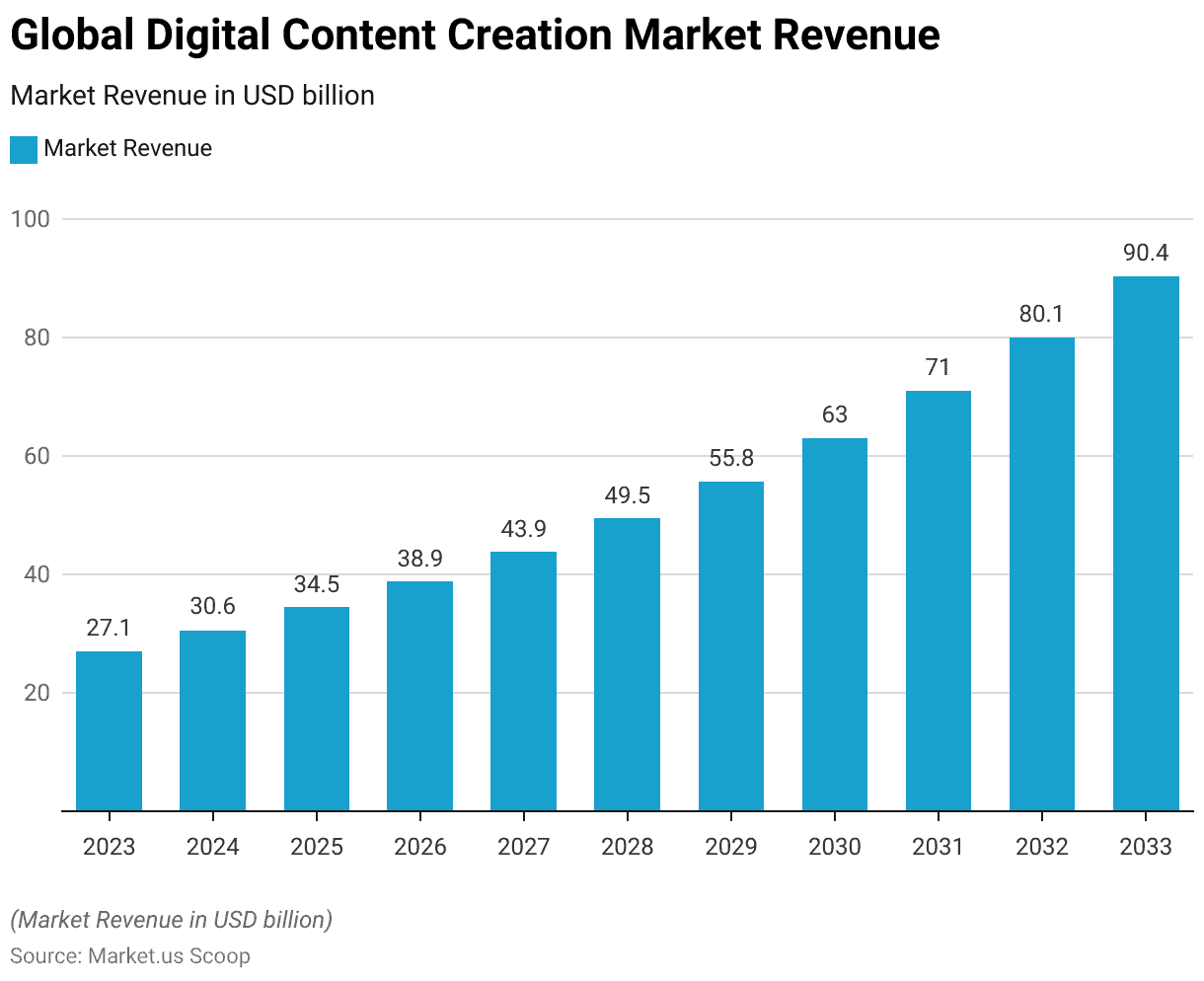
Global Digital Content Creation Market Size – By Component
- The Global Digital Content Creation market is segmented into tools and services. Showing distinct growth patterns in each category over a forecasted period from 2023 to 2033.
- In 2023, the market started with a total revenue of USD 27.1 billion. Split between USD 20.27 billion from tools and USD 6.83 billion from services.
- By 2024, the total market revenue is expected to increase to USD 30.6 billion. Comprising USD 22.89 billion from tools and USD 7.71 billion from services. This upward trend continues through the decade, with the market expanding to USD 34.5 billion in 2025. Which tools contribute USD 25.81 billion and services USD 8.69 billion.
- The growth persists, with market revenues reaching USD 38.9 billion in 2026, USD 43.9 billion in 2027, and USD 49.5 billion in 2028. Tool revenues constitute USD 29.10 billion, USD 32.84 billion, and USD 37.03 billion, respectively. While services contribute USD 9.80 billion, USD 11.06 billion, and USD 12.47 billion.
- The market size is projected to further increase to USD 55.8 billion in 2029, USD 63.0 billion in 2030, and USD 71.0 billion in 2031. Tools accounted for USD 41.74 billion, USD 47.12 billion, and USD 53.11 billion, and services generated USD 14.06 billion, USD 15.88 billion, and USD 17.89 billion respectively.
- By 2032, the market is expected to reach USD 80.1 billion. With USD 59.91 billion from tools and USD 20.19 billion from services.
- By the end of the forecast period in 2033, the total market is projected to climb to USD 90.4 billion. With tools generating USD 67.62 billion and services reaching USD 22.78 billion. Indicating a robust expansion and sustained demand across both segments.
(Source: market.us)
Take advantage of our unbeatable offer - buy now!

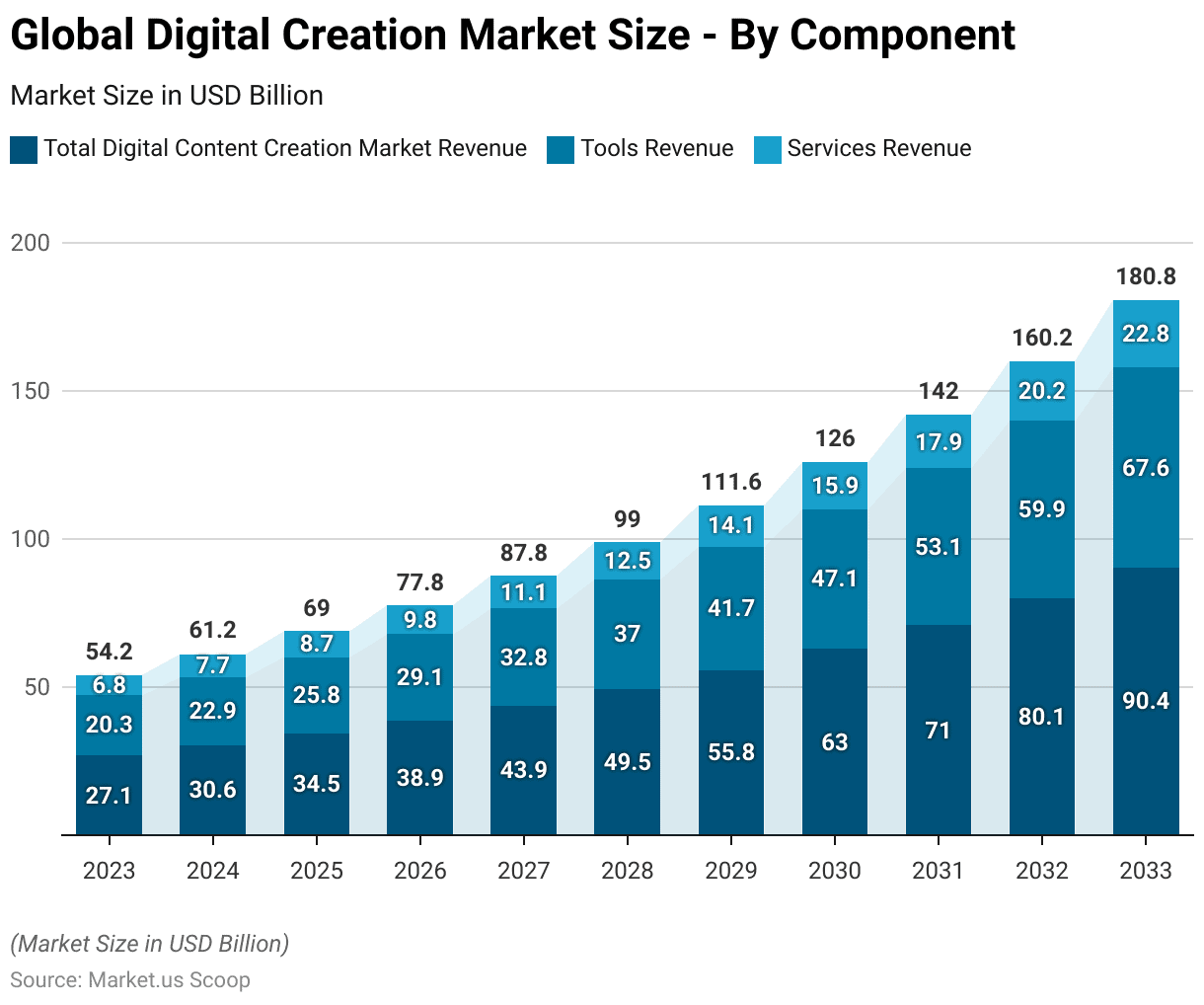
Global Digital Content Creation Market Share – By Content Type
- Various types of content are categorized in the global digital content creation market, each holding a significant share.
- Video content dominates the market with a 40% share, reflecting its widespread use and high consumer engagement.
- Graphical content follows with a 28% market share, showcasing its essential role in digital advertising and media.
- Textual content holds a 15% share, underlining its importance in content marketing and online communication.
- Audio content contributes 17% to the market, highlighting the growing popularity of podcasts and other audio-based media.
- This distribution indicates a diverse demand for different content types. With video and graphical content leading to the preference for digital content creation.
(Source: market.us)
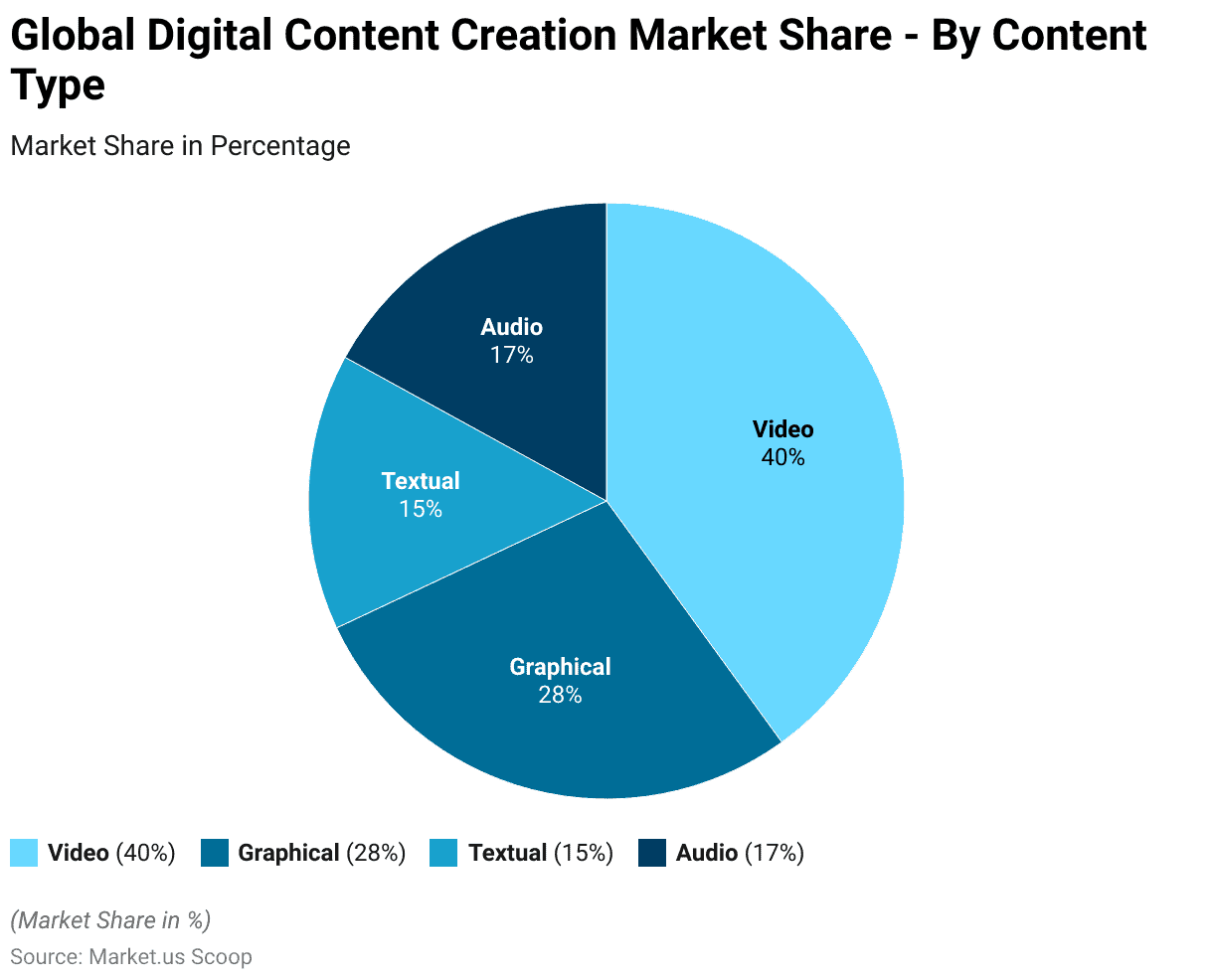
Different Types of Digital Content Creation
Video Content Creation Statistics
Most Popular Video Content – By Weekly Usage Reach
- In the third quarter of 2023, video consumption patterns worldwide showcased a diverse range of popular content types.
- An overwhelming 92% of respondents engaged with any video content, reflecting the ubiquitous nature of video in daily media consumption.
- Music videos were the second most popular, with 49.70% of respondents viewing them, illustrating their enduring appeal.
- Comedy, meme, or viral videos also held significant traction, engaging 35.30% of the audience, likely due to their entertaining and shareable nature.
- Video live streams were watched by 27.70% of respondents, suggesting a robust interest in real-time interaction and content.
- Tutorials or how-to videos, as well as educational videos, both maintained a steady interest, capturing 25.70% and 25.60% of respondents. Respectively, indicative of a strong desire for learning and skill development through video.
- Product review videos were viewed by 25% of the audience, emphasizing their role in consumer decision-making.
- Sports clips or highlights and influencer videos and vlogs also had considerable viewership at 24.90% and 23.80%, respectively.
- Lastly, gaming videos were watched by 23.20% of respondents. Highlighting the significant niche of gaming content in the digital video space.
(Source: Statista)
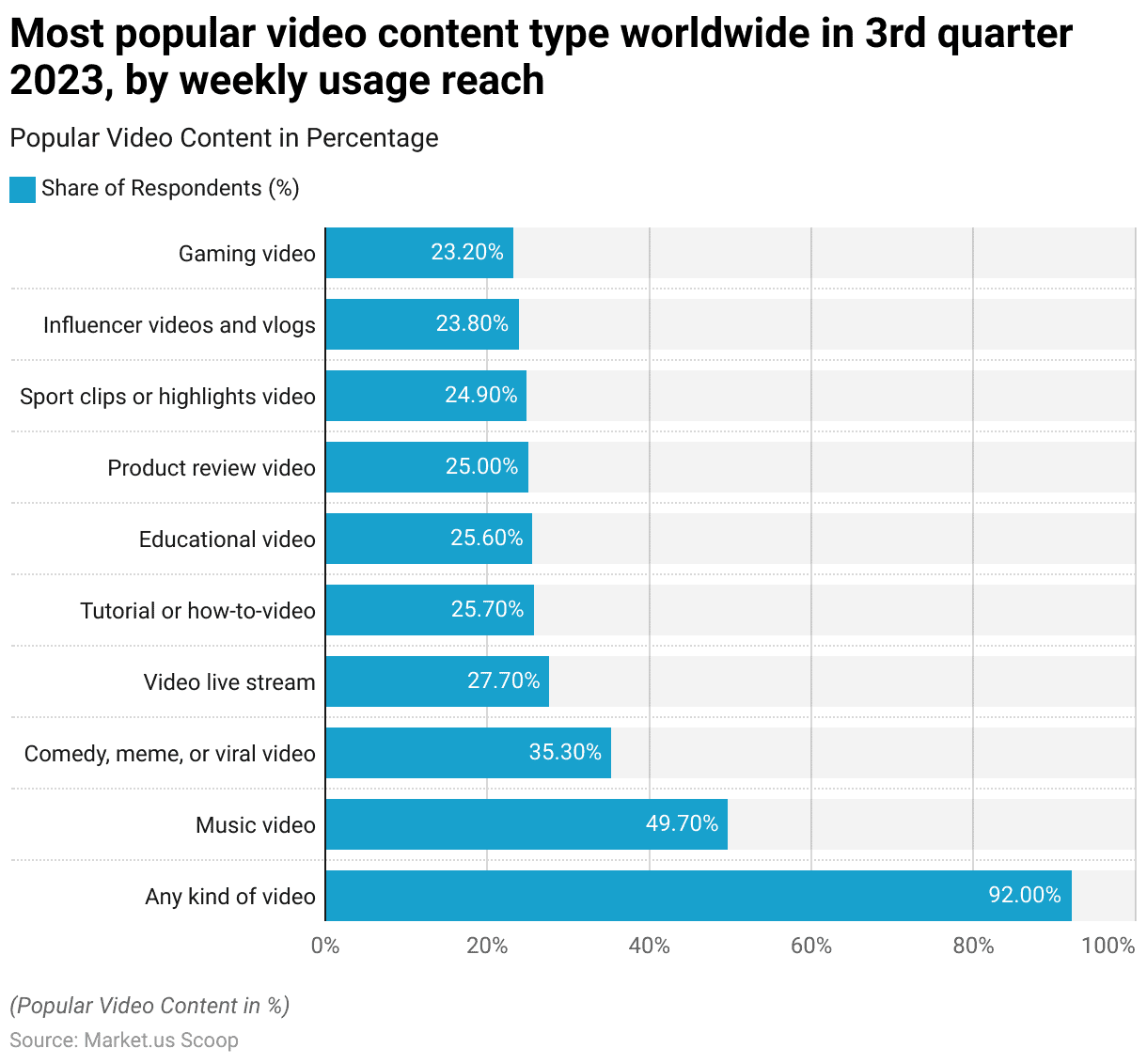
Blog Content Creation Statistics
- In the 2022 HubSpot State of Content Marketing Report, it was found that 56% of marketers believe blogs are the most effective type of content.
- Another report from OrbitMedia also emphasized the value of blogs. With 1 in 5 content creators experiencing significant success with them.
- Surprisingly, despite the crucial role of research in content creation. Only 41% of bloggers include original research in their posts, according to OrbitMedia’s survey.
- In terms of blog post length, the average post in 2021 was around 1416 words. Longer-form content (over 2,000 words) is becoming increasingly popular compared to shorter pieces.
- Bloggers are also investing more time in their posts, with a 67% increase since 2014. Now spending over 4 hours per post on average.
- Interestingly, including more than ten images in a post resulted in strong outcomes for 42% of bloggers. Yet nearly half of them (47%) only use 2 to 3 images, based on the OrbitMedia survey.
(Sources: HubSpot, OrbitMedia)
B2B & B2C Content Creation Statistics
- The HubSpot State of Inbound Marketing Trends 2022 Report indicates that B2B companies primarily focus on developing case studies, blogs, whitepapers, and interviews. In contrast, B2C businesses find shorter content formats more lucrative.
- Effective SEO strategies are essential for B2B firms to boost organic traffic and drive sales, with 77% of B2C and 66% of B2B content marketers incorporating SEO into their content creation methods.
- Looking forward, the CMI B2B Content Marketing Insights for 2022 report suggests a significant shift towards video as a key channel for B2B content creation and marketing.
- Despite this, a DemandMetric infographic reveals that almost 59% of B2B marketers still consider blogging the most effective communication channel.
- Additionally, the CMI report underscores that 80% of B2B content marketers prioritize creativity and innovation in content creation over production volume.
(Sources: HubSpot, DemandMetric, CMI B2B Content Marketing Insights)
Digital Social Media Content Creation Statistics
- A recent HubSpot survey revealed that a significant 82% of content creators and marketers repurpose their content for social media platforms.
- The HubSpot State of Inbound Marketing Trends 2022 report emphasizes that the most impactful content types for social media engagement include humor. With 80% of marketers favoring it, followed by interactive content (preferred by 77% of marketers) and content that aligns with the brand’s values (preferred by 63% of marketers).
- The report also highlights the increasing investment in social media content creation. Particularly in areas such as live streaming, short-form videos, experimental content, and live audio chat rooms.
- Moreover, it underscores that short-form video content delivers the highest return on investment (ROI) on social media.
- Alongside this, memes, infographics, and long-form videos are recognized as other content types yielding favorable ROI.
(Source: HubSpot)
Number of Digital Content Creators Worldwide – By Country
- As of May 2022, the distribution of digital content creators globally varies significantly by country.
- Brazil leads with a substantial number, hosting approximately 106 million digital content creators, the highest among surveyed nations.
- The United States follows with 86 million creators, making it another major hub for digital content production.
- Germany and Japan also contribute notable figures, with 19 million and 18.5 million content creators, respectively.
- South Korea and Spain are closely matched, having 17.5 million and 17 million content creators.
- In the United Kingdom, there are about 16.6 million digital content creators, while France has slightly fewer at 16.5 million.
- Australia, on the other hand, has a smaller community of 6 million digital content creators.
- These figures reflect the widespread and varying engagement in digital content creation across different global regions.
(Source: Statista)
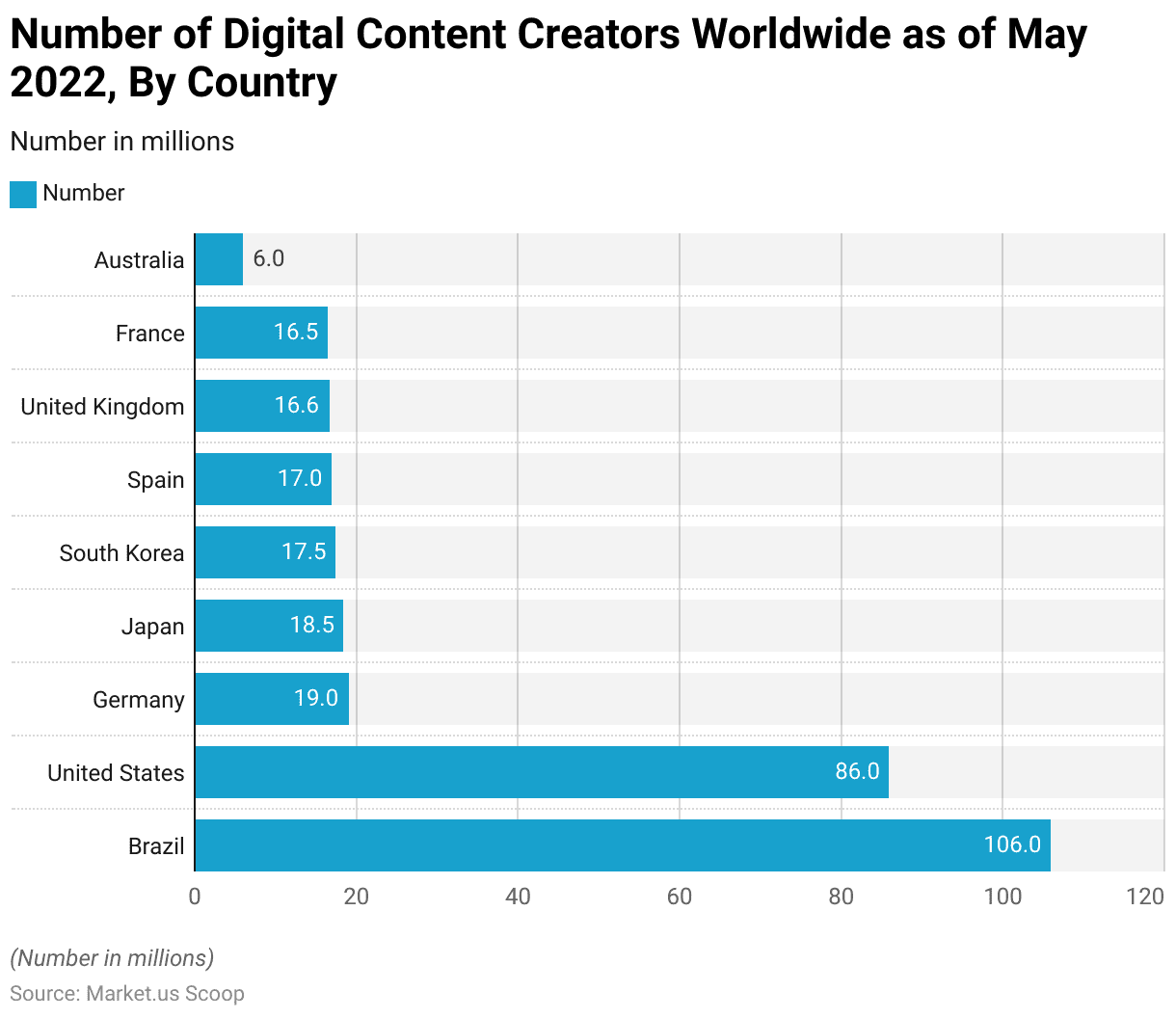
Time Spent Creating Digital Content by Social Media Creation Worldwide Statistics
- In 2021, the time invested in creating digital content by social media creators worldwide showed a diverse range of commitment.
- A small segment of respondents, 7%, reported spending between 0 to 1 hour per week on content creation, indicating a casual engagement.
- The largest group, comprising 36% of respondents, spent between 1 to 5 hours weekly, reflecting a more regular but moderate involvement.
- Another 27% dedicated 5 to 10 hours each week, suggesting a significant investment in content creation.
- A substantial 16% of creators spent 10 to 20 hours weekly, demonstrating a deeper commitment.
- Furthermore, 9% of respondents reported spending 20 to 40 hours per week, indicating near-professional or full-time engagement in content creation.
- Notably, a smaller group, 5%, invested more than 40 hours weekly. Showcasing an extensive commitment typically seen among professional content creators.
- This data illustrates the varying degrees of time and effort social media creators worldwide dedicate to digital content production.
(Source: Statista)
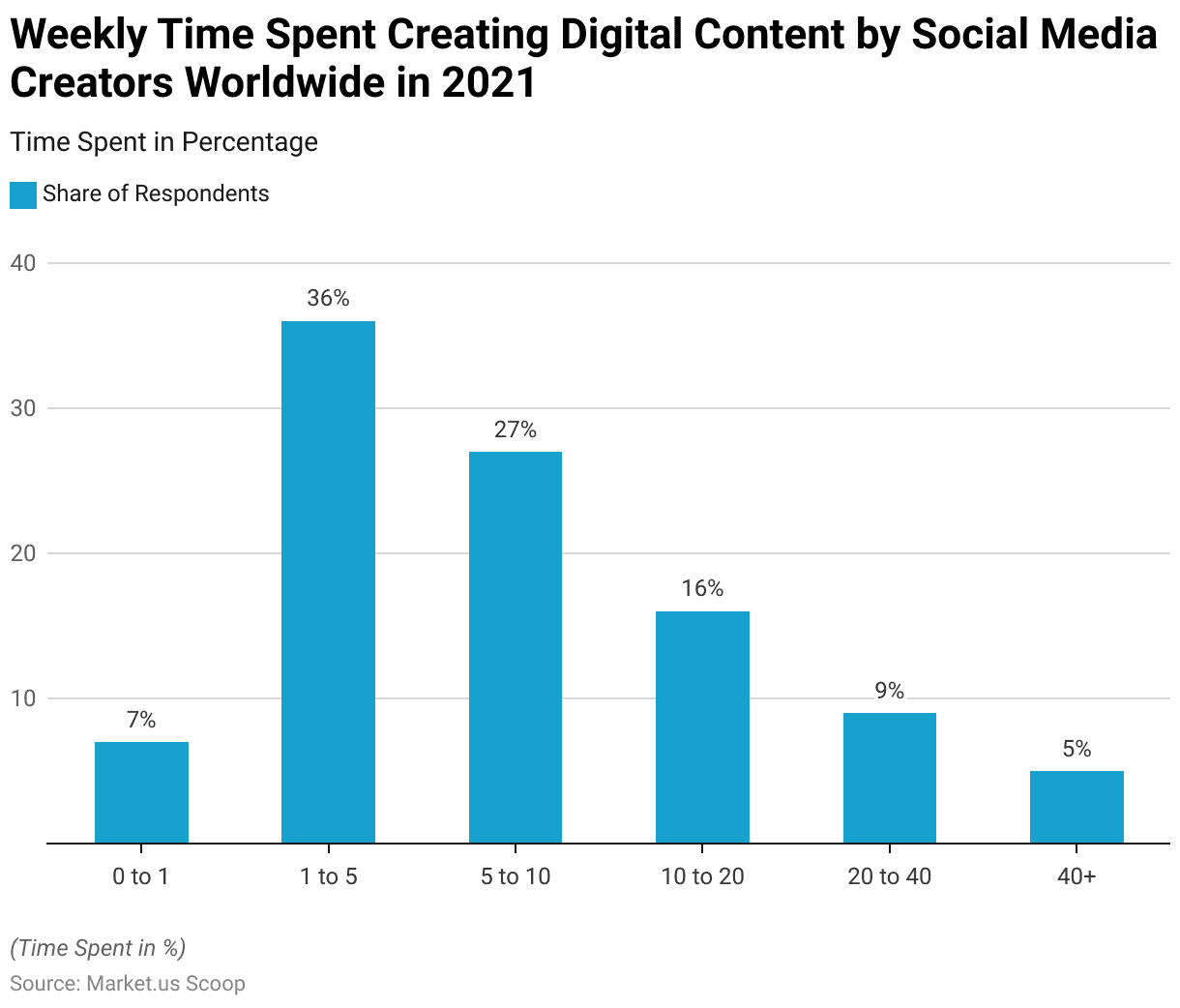
Earnings of Digital Content Creation Statistics
Revenue Generated by Digital Content Creation and Influencers via Social Media Platforms Statistics
- As of September 2023, the revenue generated by content creators and influencers via social media platforms over the last 12 months displays a wide distribution.
- A significant majority of 72% of creators earned less than $500. Indicating that most are likely engaging in content creation on a small scale or perhaps as a hobby.
- Meanwhile, 17% of creators earned between $500 and $5,000, suggesting some level of monetization beyond casual activity.
- A smaller segment of 5% generated revenues between $5,000 and $10,000. Reflecting a more substantial engagement in content creation as a potential part-time income source.
- Further up the scale, 4% of influencers earned between $10,000 and $50,000. Likely representing those who pursue content creation with a more professional approach.
- Only 2% of creators earned over $50,000, indicating a select group who have successfully leveraged their platforms to achieve significant financial returns.
- This breakdown underscores the varied financial outcomes of content creation across different levels of commitment and success.
(Source: Statista)
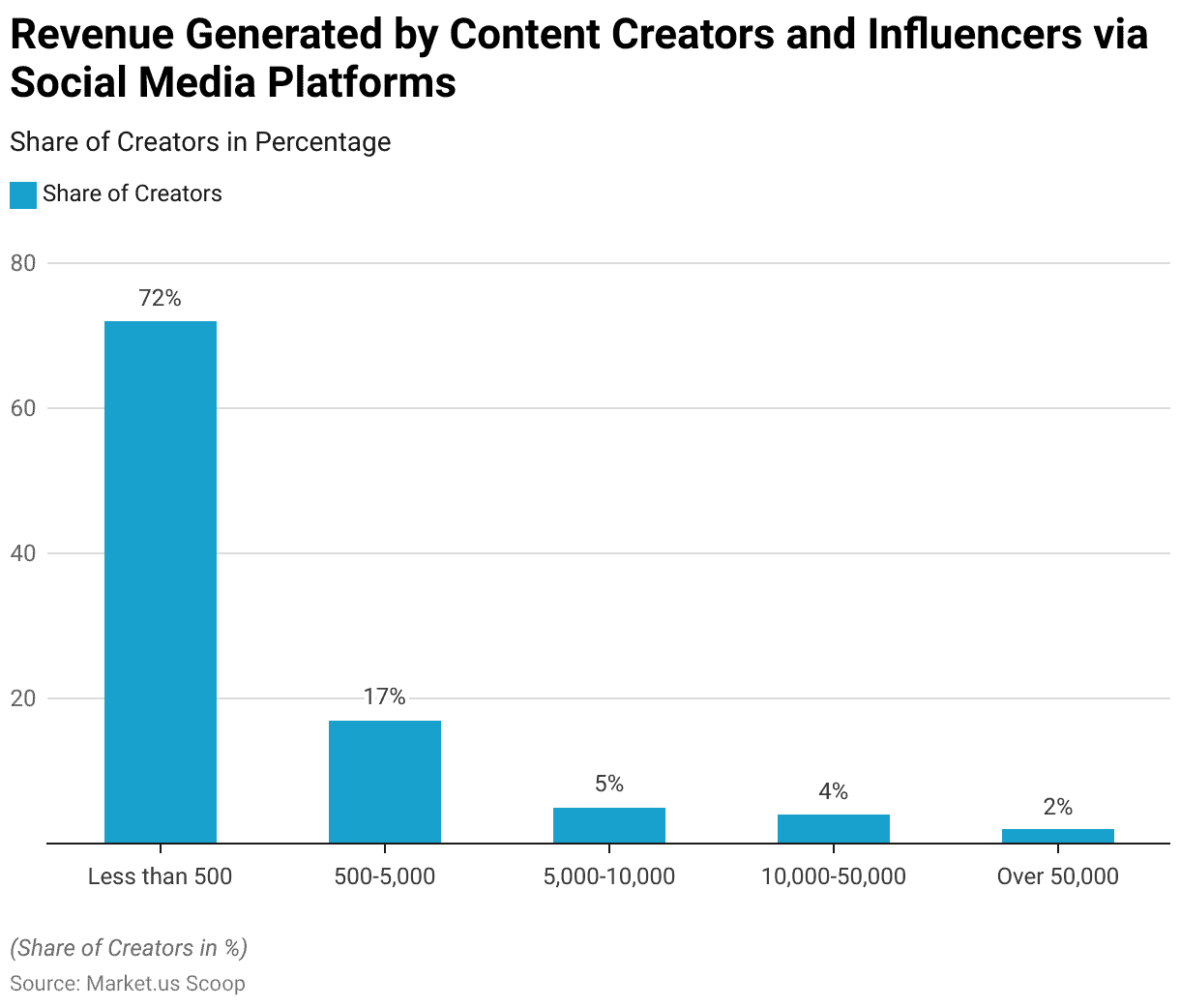
Platforms Where Online Creators Make Money
- In 2017, the earnings of U.S. creators on leading platforms exhibited varied growth and decline relative to the previous year.
- YouTube led with significant earnings of approximately $4,004 million, marking a 21.10% increase from 2016.
- Etsy also saw a positive change, generating $1,459 million with a 13.40% rise.
- Instagram showed the most substantial growth among the platforms. With earnings reaching $460 million, a 49.50% surge, indicates a rapidly increasing monetization potential on the platform.
- On the other hand, WordPress experienced a decline, with earnings dropping by 20.80% to $348 million.
- Amazon Publishing had a modest increase of 1.60%, resulting in earnings of $220 million.
- Tumblr’s earnings grew by 22.60% to $178 million, reflecting a solid increase.
- Lastly, Twitch, the streaming platform, had earnings of $87 million. Marking a significant 30% growth from the previous year.
- These figures highlight the dynamic nature of the digital content creation economy across various platforms.
(Source: Statista)
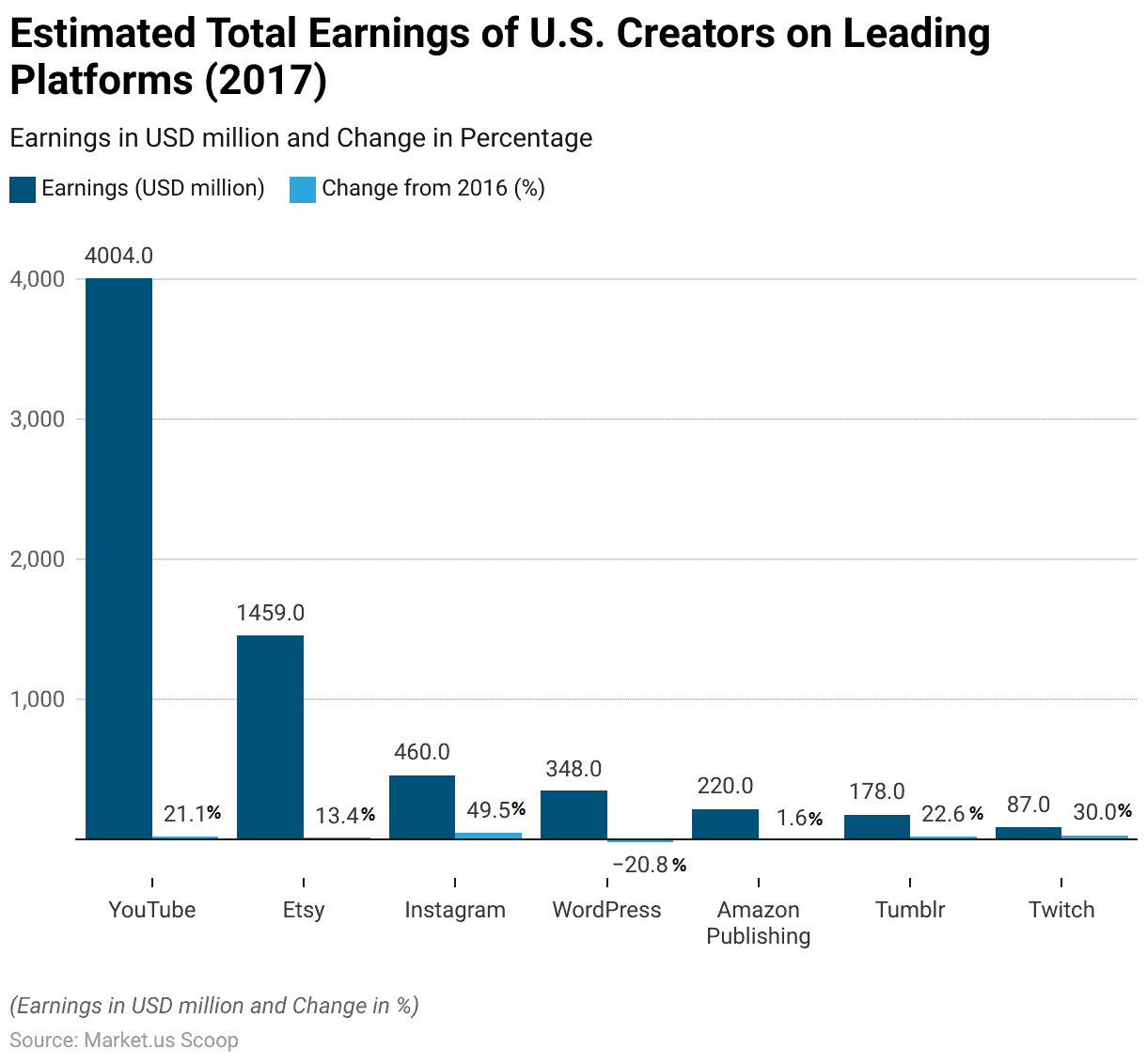
Digital Content Creation and Management Technology Statistics
- Just 31% of B2B marketers claim their organization possesses the appropriate content management technology.
- Another 30% acknowledge having the technology but not fully utilizing its capabilities, and 29% admit to not having acquired the suitable technology.
- A further 10% remain uncertain about their technological adequacy.
- Looking ahead, 45% of B2B marketers express the likelihood of their organization investing in further content management technology in 2024.
- Conversely, 32% express reluctance towards additional tech investments, while 23% remain neutral regarding the likelihood of such investments.
(Source: Content Marketing Institute)
Challenges in Digital Content Creation Statistics
- In the realm of producing engaging visual content, creators faced several notable challenges.
- The largest struggle, identified by 36.70% of respondents, was producing content consistently, highlighting the difficulty in maintaining a steady flow of fresh and engaging material.
- Finding the right layout for data, statistics, or copy was also a significant challenge, with 22.90% of respondents expressing difficulty in effectively organizing visual elements to convey their message.
- Great design posed a hurdle for 20.50% of creators, indicating that achieving an aesthetically pleasing and impactful presentation is a common concern.
- Additionally, sourcing data and statistics necessary for writing the copy was a struggle for 19.90% of respondents, underscoring the importance of robust and relevant data to inform and enrich visual content.
- These challenges collectively reflect the complexities involved in crafting high-quality visual content that resonates with audiences.
(Source: Venngage)
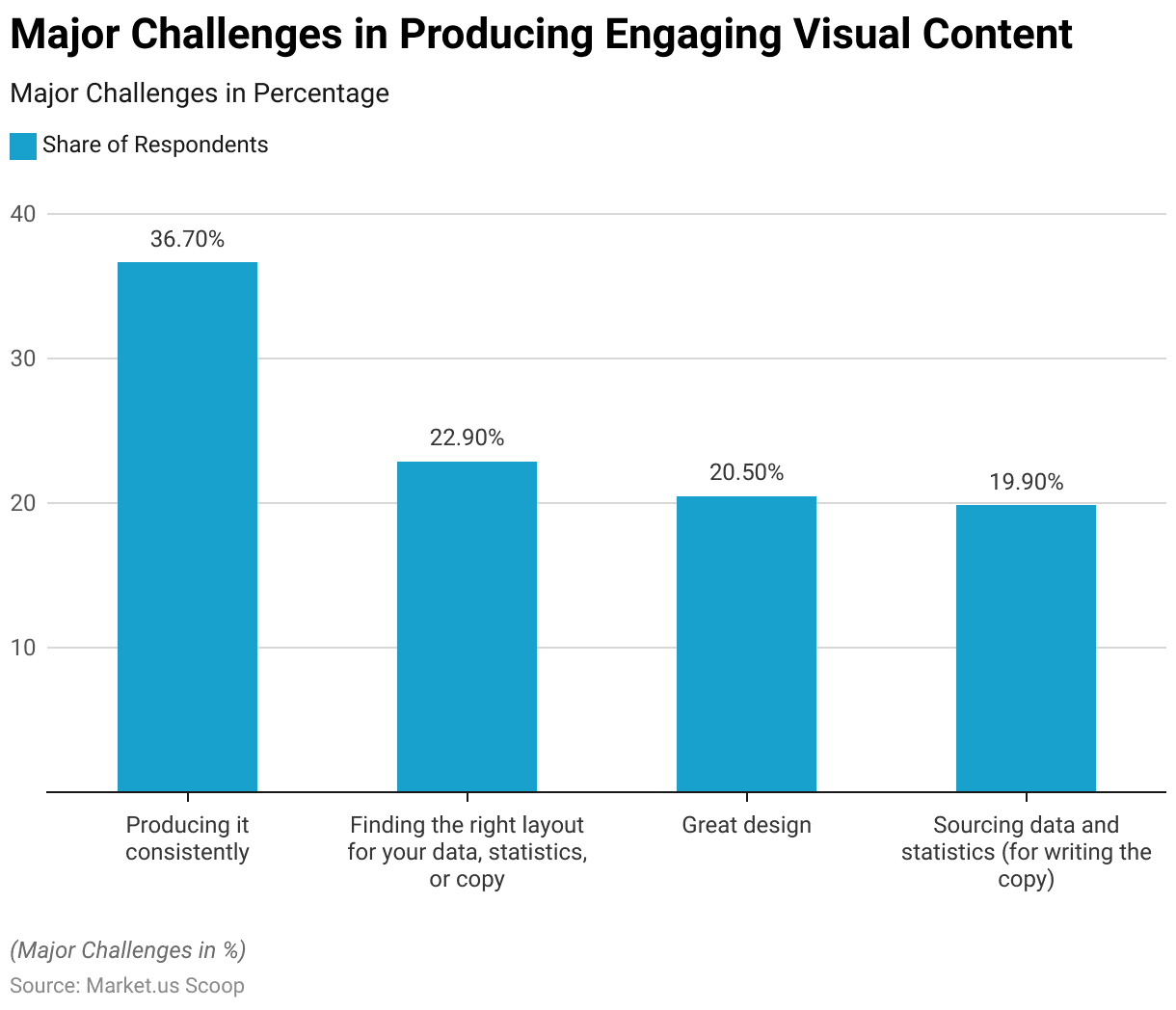
Recent Developments
Acquisitions and Mergers:
In the past quarter, the digital content creation landscape witnessed several notable acquisitions and mergers. For instance:
- Adobe Systems Incorporated acquired Alloy Entertainment, a leading content creation company, for an undisclosed sum, bolstering its offerings in digital storytelling and media production.
- Shutterstock Inc. completed its acquisition of PicMonkey, a popular online photo editing and graphic design platform, expanding its suite of creative tools for content creators.
New Product Launches:
Companies have introduced innovative tools and platforms to enhance digital content creation efficiency and quality:
- Canva, a prominent graphic design platform, launched Canva Video, enabling users to create engaging videos effortlessly with customizable templates and easy-to-use editing features.
- TikTok announced the rollout of TikTok Resumes, a new feature allowing users to showcase their professional skills and experience through short-form video resumes, tapping into the growing trend of video-based job applications.
Funding Rounds:
Digital content creation startups secured significant funding to fuel their growth and innovation initiatives:
- Loom, a video messaging platform, raised $130 million in a Series C funding round led by Sequoia Capital, aiming to expand its product offerings and accelerate user acquisition.
- Descript, an audio and video editing software company, secured $30 million in Series B funding led by Spark Capital, signaling investor confidence in the demand for innovative content creation tools.
Partnerships and Collaborations:
Collaborative efforts between industry players have resulted in strategic partnerships to leverage complementary strengths:
- Vimeo partnered with Shopify to integrate Vimeo’s video creation and hosting capabilities directly into the Shopify platform, empowering merchants to enhance their online presence with compelling video content.
- Google Workspace announced a collaboration with Canva, enabling users to seamlessly access and integrate Canva’s design tools within Google Docs and Google Slides, facilitating streamlined content creation workflows.
Emerging Trends:
The digital content creation landscape continues to evolve, with emerging trends shaping industry dynamics:
- The rising popularity of user-generated content (UGC) platforms like TikTok and Instagram Reels underscores the growing demand for authentic and engaging content created by individuals.
- Increasing emphasis on inclusivity and diversity in content creation is driving initiatives by platforms and brands to amplify underrepresented voices and perspectives, reflecting evolving societal values and preferences.
Conclusion
Digital Content Creation Statistics – The digital content creation market is on a rapid ascent, fueled by an increase in the number of content creators and the popularity of diverse content types, particularly video.
Projected market revenue growth, along with a wide range of earnings among creators, underscores a dynamic and competitive landscape.
Challenges such as content consistency, design, and data sourcing persist, emphasizing the need for ongoing skill enhancement and advanced creation tools.
The role of social media platforms is crucial, influencing both the distribution and monetization of content.
As technologies like AI and VR become more integrated, they promise to expand the capabilities and reach of digital content further. Pointing to a future rich with opportunities for creators and marketers alike.
FAQs
Digital content creation involves producing material like videos, blogs, graphics, and audio for use on digital platforms such as websites, social media, and streaming services. The content is designed to inform, entertain, or engage specific audiences.
Essential tools vary by content type but generally include video editing software (like Adobe Premiere Pro), graphic design tools (such as Adobe Illustrator and Photoshop), content management systems (like WordPress), and audio editing programs (e.g., Audacity).
Engaging content is typically well-targeted, visually appealing, informative or entertaining, and interactive. It often includes clear calls to action high-quality visuals, and is tailored to the preferences of a specific audience.
Current trends include the use of artificial intelligence for content personalization, increased emphasis on video content across platforms, the integration of augmented and virtual reality, and a focus on authenticity and community-building in content strategy.
Challenges include maintaining a consistent content schedule, keeping up with changing platform algorithms, ensuring content visibility, securing adequate funding, and managing copyright issues.
Discuss your needs with our analyst
Please share your requirements with more details so our analyst can check if they can solve your problem(s)



